Business Intelligence in Cloud Computing: Analysis and Implications
VerifiedAdded on 2023/06/09
|11
|5470
|339
Report
AI Summary
This paper, "Business Intelligence in Cloud," reviews and critiques current research on the topic, focusing on the challenges organizations face when using BI in the cloud. It aims to conceptualize the issue and investigate the benefits and risks associated with BI cloud solutions. The study, based on literature analysis and reports, provides insights for IT and business leaders planning and developing BI cloud strategies. The paper covers the theoretical foundations of BI and cloud computing, conceptualizes BI cloud, and explores its benefits and risks. It highlights the evolution of BI, the challenges organizations face (such as reducing costs and handling large data volumes), and how cloud computing offers solutions. The paper defines cloud computing, discusses its features, and examines different cloud layers (industry, application, platform, and infrastructure). The paper then conceptualizes cloud BI, describing it as a cost-effective and flexible approach to delivering business intelligence capabilities, and notes its appeal to organizations seeking to improve agility and reduce IT costs. It also mentions the cloud BI platform's role in addressing customer needs such as horizontal BI tools. The paper emphasizes the importance of cloud BI in transforming the economics of BI, making it accessible to smaller enterprises.
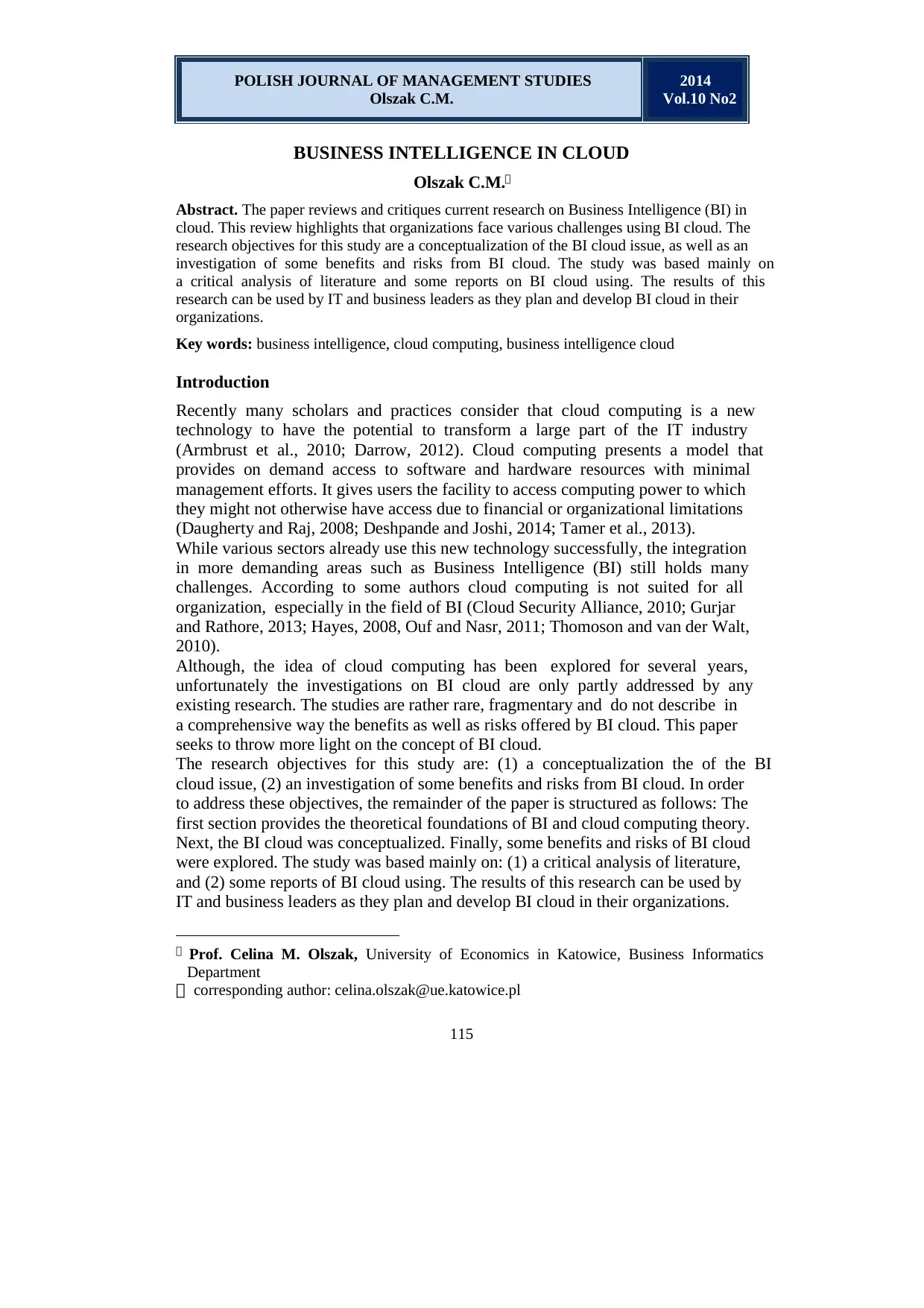
POLISH JOURNAL OF MANAGEMENT STUDIES
Olszak C.M.
2014
Vol.10 No2
115
BUSINESS INTELLIGENCE IN CLOUD
Olszak C.M.
Abstract. The paper reviews and critiques current research on Business Intelligence (BI) in
cloud. This review highlights that organizations face various challenges using BI cloud. The
research objectives for this study are a conceptualization of the BI cloud issue, as well as an
investigation of some benefits and risks from BI cloud. The study was based mainly on
a critical analysis of literature and some reports on BI cloud using. The results of this
research can be used by IT and business leaders as they plan and develop BI cloud in their
organizations.
Key words: business intelligence, cloud computing, business intelligence cloud
Introduction
Recently many scholars and practices consider that cloud computing is a new
technology to have the potential to transform a large part of the IT industry
(Armbrust et al., 2010; Darrow, 2012). Cloud computing presents a model that
provides on demand access to software and hardware resources with minimal
management efforts. It gives users the facility to access computing power to which
they might not otherwise have access due to financial or organizational limitations
(Daugherty and Raj, 2008; Deshpande and Joshi, 2014; Tamer et al., 2013).
While various sectors already use this new technology successfully, the integration
in more demanding areas such as Business Intelligence (BI) still holds many
challenges. According to some authors cloud computing is not suited for all
organization, especially in the field of BI (Cloud Security Alliance, 2010; Gurjar
and Rathore, 2013; Hayes, 2008, Ouf and Nasr, 2011; Thomoson and van der Walt,
2010).
Although, the idea of cloud computing has been explored for several years,
unfortunately the investigations on BI cloud are only partly addressed by any
existing research. The studies are rather rare, fragmentary and do not describe in
a comprehensive way the benefits as well as risks offered by BI cloud. This paper
seeks to throw more light on the concept of BI cloud.
The research objectives for this study are: (1) a conceptualization the of the BI
cloud issue, (2) an investigation of some benefits and risks from BI cloud. In order
to address these objectives, the remainder of the paper is structured as follows: The
first section provides the theoretical foundations of BI and cloud computing theory.
Next, the BI cloud was conceptualized. Finally, some benefits and risks of BI cloud
were explored. The study was based mainly on: (1) a critical analysis of literature,
and (2) some reports of BI cloud using. The results of this research can be used by
IT and business leaders as they plan and develop BI cloud in their organizations.
Prof. Celina M. Olszak, University of Economics in Katowice, Business Informatics
Department
corresponding author: celina.olszak@ue.katowice.pl
Olszak C.M.
2014
Vol.10 No2
115
BUSINESS INTELLIGENCE IN CLOUD
Olszak C.M.
Abstract. The paper reviews and critiques current research on Business Intelligence (BI) in
cloud. This review highlights that organizations face various challenges using BI cloud. The
research objectives for this study are a conceptualization of the BI cloud issue, as well as an
investigation of some benefits and risks from BI cloud. The study was based mainly on
a critical analysis of literature and some reports on BI cloud using. The results of this
research can be used by IT and business leaders as they plan and develop BI cloud in their
organizations.
Key words: business intelligence, cloud computing, business intelligence cloud
Introduction
Recently many scholars and practices consider that cloud computing is a new
technology to have the potential to transform a large part of the IT industry
(Armbrust et al., 2010; Darrow, 2012). Cloud computing presents a model that
provides on demand access to software and hardware resources with minimal
management efforts. It gives users the facility to access computing power to which
they might not otherwise have access due to financial or organizational limitations
(Daugherty and Raj, 2008; Deshpande and Joshi, 2014; Tamer et al., 2013).
While various sectors already use this new technology successfully, the integration
in more demanding areas such as Business Intelligence (BI) still holds many
challenges. According to some authors cloud computing is not suited for all
organization, especially in the field of BI (Cloud Security Alliance, 2010; Gurjar
and Rathore, 2013; Hayes, 2008, Ouf and Nasr, 2011; Thomoson and van der Walt,
2010).
Although, the idea of cloud computing has been explored for several years,
unfortunately the investigations on BI cloud are only partly addressed by any
existing research. The studies are rather rare, fragmentary and do not describe in
a comprehensive way the benefits as well as risks offered by BI cloud. This paper
seeks to throw more light on the concept of BI cloud.
The research objectives for this study are: (1) a conceptualization the of the BI
cloud issue, (2) an investigation of some benefits and risks from BI cloud. In order
to address these objectives, the remainder of the paper is structured as follows: The
first section provides the theoretical foundations of BI and cloud computing theory.
Next, the BI cloud was conceptualized. Finally, some benefits and risks of BI cloud
were explored. The study was based mainly on: (1) a critical analysis of literature,
and (2) some reports of BI cloud using. The results of this research can be used by
IT and business leaders as they plan and develop BI cloud in their organizations.
Prof. Celina M. Olszak, University of Economics in Katowice, Business Informatics
Department
corresponding author: celina.olszak@ue.katowice.pl
Paraphrase This Document
Need a fresh take? Get an instant paraphrase of this document with our AI Paraphraser
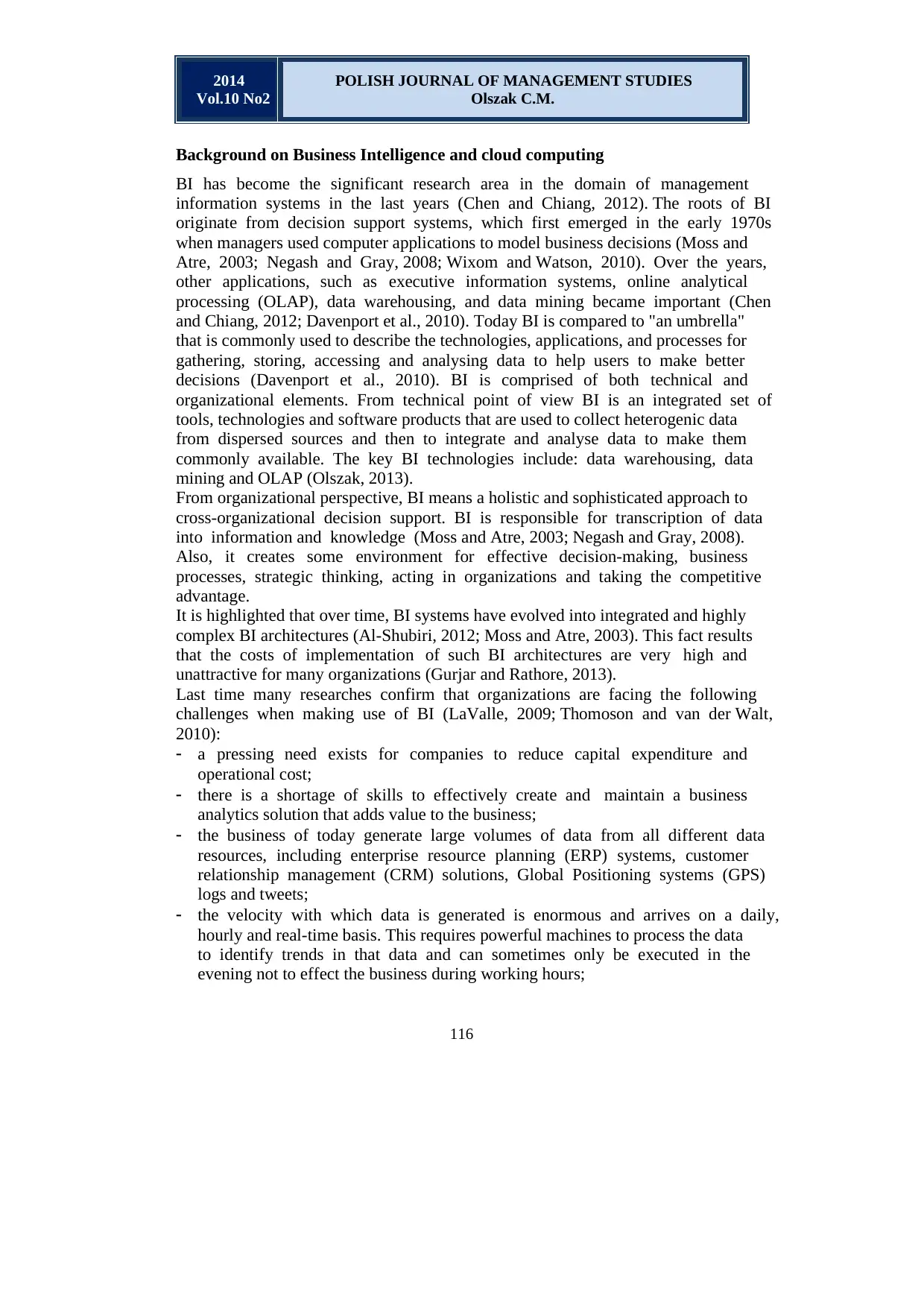
2014
Vol.10 No2
POLISH JOURNAL OF MANAGEMENT STUDIES
Olszak C.M.
116
Background on Business Intelligence and cloud computing
BI has become the significant research area in the domain of management
information systems in the last years (Chen and Chiang, 2012). The roots of BI
originate from decision support systems, which first emerged in the early 1970s
when managers used computer applications to model business decisions (Moss and
Atre, 2003; Negash and Gray, 2008; Wixom and Watson, 2010). Over the years,
other applications, such as executive information systems, online analytical
processing (OLAP), data warehousing, and data mining became important (Chen
and Chiang, 2012; Davenport et al., 2010). Today BI is compared to "an umbrella"
that is commonly used to describe the technologies, applications, and processes for
gathering, storing, accessing and analysing data to help users to make better
decisions (Davenport et al., 2010). BI is comprised of both technical and
organizational elements. From technical point of view BI is an integrated set of
tools, technologies and software products that are used to collect heterogenic data
from dispersed sources and then to integrate and analyse data to make them
commonly available. The key BI technologies include: data warehousing, data
mining and OLAP (Olszak, 2013).
From organizational perspective, BI means a holistic and sophisticated approach to
cross-organizational decision support. BI is responsible for transcription of data
into information and knowledge (Moss and Atre, 2003; Negash and Gray, 2008).
Also, it creates some environment for effective decision-making, business
processes, strategic thinking, acting in organizations and taking the competitive
advantage.
It is highlighted that over time, BI systems have evolved into integrated and highly
complex BI architectures (Al-Shubiri, 2012; Moss and Atre, 2003). This fact results
that the costs of implementation of such BI architectures are very high and
unattractive for many organizations (Gurjar and Rathore, 2013).
Last time many researches confirm that organizations are facing the following
challenges when making use of BI (LaValle, 2009; Thomoson and van der Walt,
2010):
a pressing need exists for companies to reduce capital expenditure and
operational cost;
there is a shortage of skills to effectively create and maintain a business
analytics solution that adds value to the business;
the business of today generate large volumes of data from all different data
resources, including enterprise resource planning (ERP) systems, customer
relationship management (CRM) solutions, Global Positioning systems (GPS)
logs and tweets;
the velocity with which data is generated is enormous and arrives on a daily,
hourly and real-time basis. This requires powerful machines to process the data
to identify trends in that data and can sometimes only be executed in the
evening not to effect the business during working hours;
Vol.10 No2
POLISH JOURNAL OF MANAGEMENT STUDIES
Olszak C.M.
116
Background on Business Intelligence and cloud computing
BI has become the significant research area in the domain of management
information systems in the last years (Chen and Chiang, 2012). The roots of BI
originate from decision support systems, which first emerged in the early 1970s
when managers used computer applications to model business decisions (Moss and
Atre, 2003; Negash and Gray, 2008; Wixom and Watson, 2010). Over the years,
other applications, such as executive information systems, online analytical
processing (OLAP), data warehousing, and data mining became important (Chen
and Chiang, 2012; Davenport et al., 2010). Today BI is compared to "an umbrella"
that is commonly used to describe the technologies, applications, and processes for
gathering, storing, accessing and analysing data to help users to make better
decisions (Davenport et al., 2010). BI is comprised of both technical and
organizational elements. From technical point of view BI is an integrated set of
tools, technologies and software products that are used to collect heterogenic data
from dispersed sources and then to integrate and analyse data to make them
commonly available. The key BI technologies include: data warehousing, data
mining and OLAP (Olszak, 2013).
From organizational perspective, BI means a holistic and sophisticated approach to
cross-organizational decision support. BI is responsible for transcription of data
into information and knowledge (Moss and Atre, 2003; Negash and Gray, 2008).
Also, it creates some environment for effective decision-making, business
processes, strategic thinking, acting in organizations and taking the competitive
advantage.
It is highlighted that over time, BI systems have evolved into integrated and highly
complex BI architectures (Al-Shubiri, 2012; Moss and Atre, 2003). This fact results
that the costs of implementation of such BI architectures are very high and
unattractive for many organizations (Gurjar and Rathore, 2013).
Last time many researches confirm that organizations are facing the following
challenges when making use of BI (LaValle, 2009; Thomoson and van der Walt,
2010):
a pressing need exists for companies to reduce capital expenditure and
operational cost;
there is a shortage of skills to effectively create and maintain a business
analytics solution that adds value to the business;
the business of today generate large volumes of data from all different data
resources, including enterprise resource planning (ERP) systems, customer
relationship management (CRM) solutions, Global Positioning systems (GPS)
logs and tweets;
the velocity with which data is generated is enormous and arrives on a daily,
hourly and real-time basis. This requires powerful machines to process the data
to identify trends in that data and can sometimes only be executed in the
evening not to effect the business during working hours;
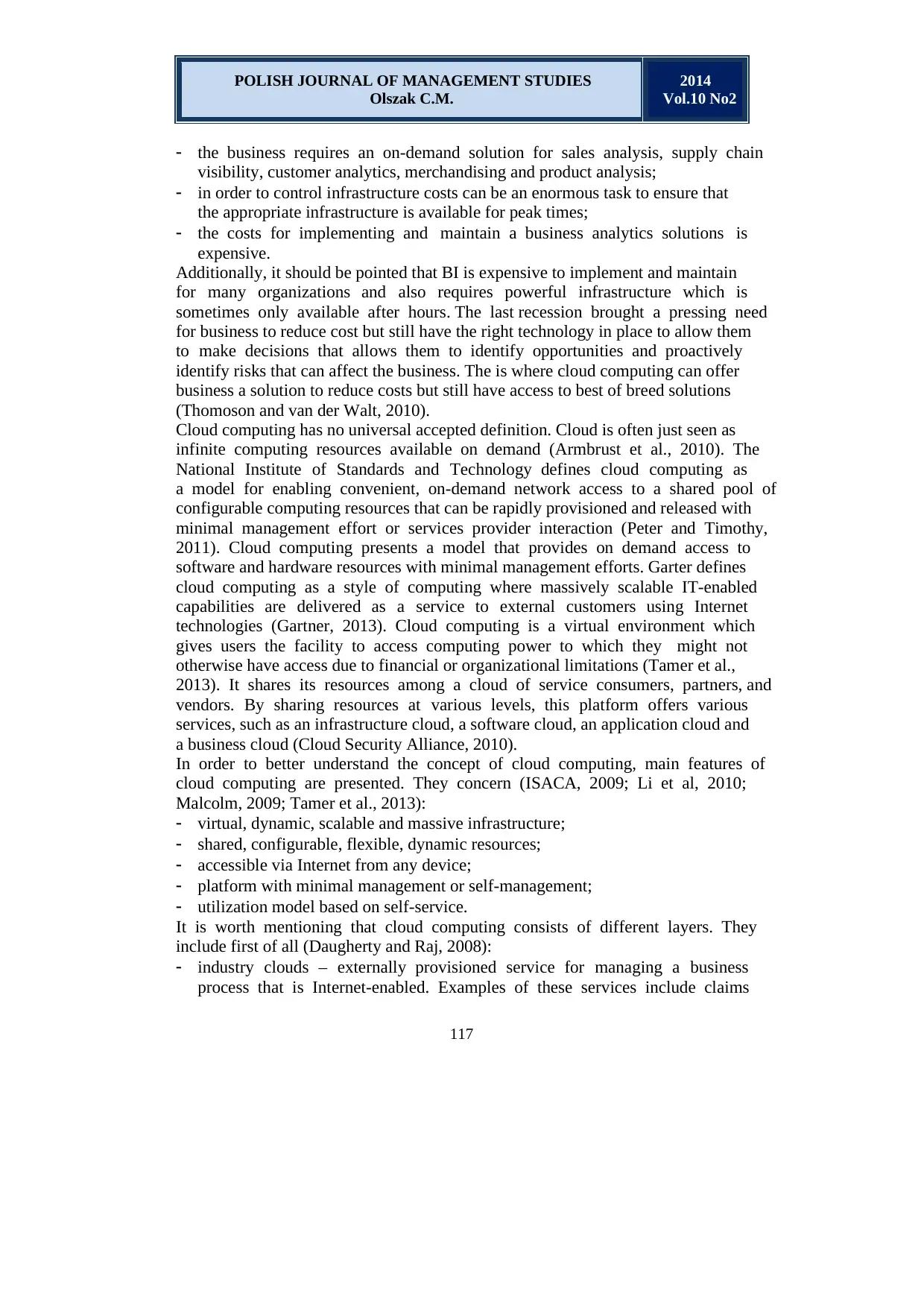
POLISH JOURNAL OF MANAGEMENT STUDIES
Olszak C.M.
2014
Vol.10 No2
117
the business requires an on-demand solution for sales analysis, supply chain
visibility, customer analytics, merchandising and product analysis;
in order to control infrastructure costs can be an enormous task to ensure that
the appropriate infrastructure is available for peak times;
the costs for implementing and maintain a business analytics solutions is
expensive.
Additionally, it should be pointed that BI is expensive to implement and maintain
for many organizations and also requires powerful infrastructure which is
sometimes only available after hours. The last recession brought a pressing need
for business to reduce cost but still have the right technology in place to allow them
to make decisions that allows them to identify opportunities and proactively
identify risks that can affect the business. The is where cloud computing can offer
business a solution to reduce costs but still have access to best of breed solutions
(Thomoson and van der Walt, 2010).
Cloud computing has no universal accepted definition. Cloud is often just seen as
infinite computing resources available on demand (Armbrust et al., 2010). The
National Institute of Standards and Technology defines cloud computing as
a model for enabling convenient, on-demand network access to a shared pool of
configurable computing resources that can be rapidly provisioned and released with
minimal management effort or services provider interaction (Peter and Timothy,
2011). Cloud computing presents a model that provides on demand access to
software and hardware resources with minimal management efforts. Garter defines
cloud computing as a style of computing where massively scalable IT-enabled
capabilities are delivered as a service to external customers using Internet
technologies (Gartner, 2013). Cloud computing is a virtual environment which
gives users the facility to access computing power to which they might not
otherwise have access due to financial or organizational limitations (Tamer et al.,
2013). It shares its resources among a cloud of service consumers, partners, and
vendors. By sharing resources at various levels, this platform offers various
services, such as an infrastructure cloud, a software cloud, an application cloud and
a business cloud (Cloud Security Alliance, 2010).
In order to better understand the concept of cloud computing, main features of
cloud computing are presented. They concern (ISACA, 2009; Li et al, 2010;
Malcolm, 2009; Tamer et al., 2013):
virtual, dynamic, scalable and massive infrastructure;
shared, configurable, flexible, dynamic resources;
accessible via Internet from any device;
platform with minimal management or self-management;
utilization model based on self-service.
It is worth mentioning that cloud computing consists of different layers. They
include first of all (Daugherty and Raj, 2008):
industry clouds – externally provisioned service for managing a business
process that is Internet-enabled. Examples of these services include claims
Olszak C.M.
2014
Vol.10 No2
117
the business requires an on-demand solution for sales analysis, supply chain
visibility, customer analytics, merchandising and product analysis;
in order to control infrastructure costs can be an enormous task to ensure that
the appropriate infrastructure is available for peak times;
the costs for implementing and maintain a business analytics solutions is
expensive.
Additionally, it should be pointed that BI is expensive to implement and maintain
for many organizations and also requires powerful infrastructure which is
sometimes only available after hours. The last recession brought a pressing need
for business to reduce cost but still have the right technology in place to allow them
to make decisions that allows them to identify opportunities and proactively
identify risks that can affect the business. The is where cloud computing can offer
business a solution to reduce costs but still have access to best of breed solutions
(Thomoson and van der Walt, 2010).
Cloud computing has no universal accepted definition. Cloud is often just seen as
infinite computing resources available on demand (Armbrust et al., 2010). The
National Institute of Standards and Technology defines cloud computing as
a model for enabling convenient, on-demand network access to a shared pool of
configurable computing resources that can be rapidly provisioned and released with
minimal management effort or services provider interaction (Peter and Timothy,
2011). Cloud computing presents a model that provides on demand access to
software and hardware resources with minimal management efforts. Garter defines
cloud computing as a style of computing where massively scalable IT-enabled
capabilities are delivered as a service to external customers using Internet
technologies (Gartner, 2013). Cloud computing is a virtual environment which
gives users the facility to access computing power to which they might not
otherwise have access due to financial or organizational limitations (Tamer et al.,
2013). It shares its resources among a cloud of service consumers, partners, and
vendors. By sharing resources at various levels, this platform offers various
services, such as an infrastructure cloud, a software cloud, an application cloud and
a business cloud (Cloud Security Alliance, 2010).
In order to better understand the concept of cloud computing, main features of
cloud computing are presented. They concern (ISACA, 2009; Li et al, 2010;
Malcolm, 2009; Tamer et al., 2013):
virtual, dynamic, scalable and massive infrastructure;
shared, configurable, flexible, dynamic resources;
accessible via Internet from any device;
platform with minimal management or self-management;
utilization model based on self-service.
It is worth mentioning that cloud computing consists of different layers. They
include first of all (Daugherty and Raj, 2008):
industry clouds – externally provisioned service for managing a business
process that is Internet-enabled. Examples of these services include claims
⊘ This is a preview!⊘
Do you want full access?
Subscribe today to unlock all pages.

Trusted by 1+ million students worldwide
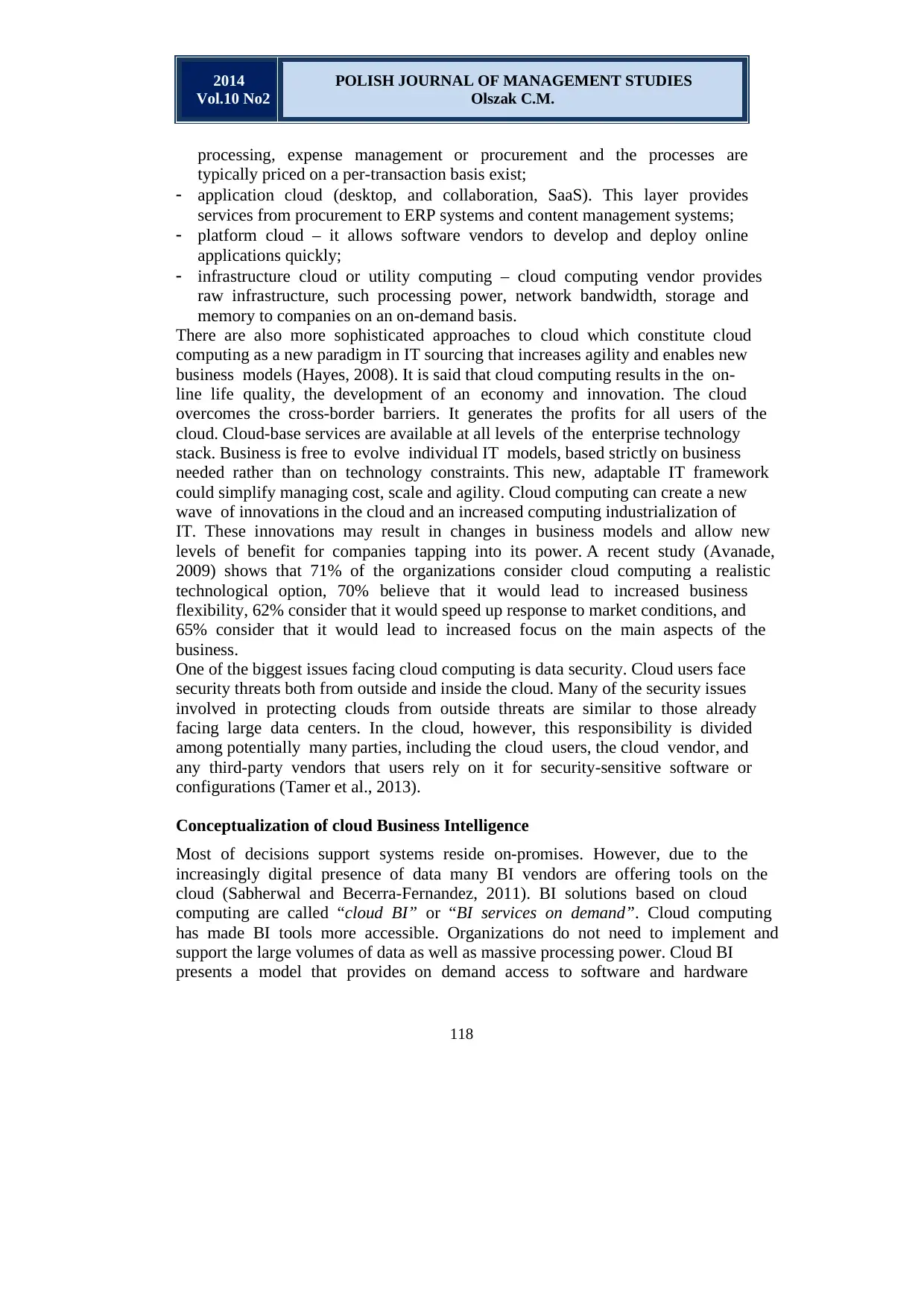
2014
Vol.10 No2
POLISH JOURNAL OF MANAGEMENT STUDIES
Olszak C.M.
118
processing, expense management or procurement and the processes are
typically priced on a per-transaction basis exist;
application cloud (desktop, and collaboration, SaaS). This layer provides
services from procurement to ERP systems and content management systems;
platform cloud – it allows software vendors to develop and deploy online
applications quickly;
infrastructure cloud or utility computing – cloud computing vendor provides
raw infrastructure, such processing power, network bandwidth, storage and
memory to companies on an on-demand basis.
There are also more sophisticated approaches to cloud which constitute cloud
computing as a new paradigm in IT sourcing that increases agility and enables new
business models (Hayes, 2008). It is said that cloud computing results in the on-
line life quality, the development of an economy and innovation. The cloud
overcomes the cross-border barriers. It generates the profits for all users of the
cloud. Cloud-base services are available at all levels of the enterprise technology
stack. Business is free to evolve individual IT models, based strictly on business
needed rather than on technology constraints. This new, adaptable IT framework
could simplify managing cost, scale and agility. Cloud computing can create a new
wave of innovations in the cloud and an increased computing industrialization of
IT. These innovations may result in changes in business models and allow new
levels of benefit for companies tapping into its power. A recent study (Avanade,
2009) shows that 71% of the organizations consider cloud computing a realistic
technological option, 70% believe that it would lead to increased business
flexibility, 62% consider that it would speed up response to market conditions, and
65% consider that it would lead to increased focus on the main aspects of the
business.
One of the biggest issues facing cloud computing is data security. Cloud users face
security threats both from outside and inside the cloud. Many of the security issues
involved in protecting clouds from outside threats are similar to those already
facing large data centers. In the cloud, however, this responsibility is divided
among potentially many parties, including the cloud users, the cloud vendor, and
any third-party vendors that users rely on it for security-sensitive software or
configurations (Tamer et al., 2013).
Conceptualization of cloud Business Intelligence
Most of decisions support systems reside on-promises. However, due to the
increasingly digital presence of data many BI vendors are offering tools on the
cloud (Sabherwal and Becerra-Fernandez, 2011). BI solutions based on cloud
computing are called “cloud BI” or “BI services on demand”. Cloud computing
has made BI tools more accessible. Organizations do not need to implement and
support the large volumes of data as well as massive processing power. Cloud BI
presents a model that provides on demand access to software and hardware
Vol.10 No2
POLISH JOURNAL OF MANAGEMENT STUDIES
Olszak C.M.
118
processing, expense management or procurement and the processes are
typically priced on a per-transaction basis exist;
application cloud (desktop, and collaboration, SaaS). This layer provides
services from procurement to ERP systems and content management systems;
platform cloud – it allows software vendors to develop and deploy online
applications quickly;
infrastructure cloud or utility computing – cloud computing vendor provides
raw infrastructure, such processing power, network bandwidth, storage and
memory to companies on an on-demand basis.
There are also more sophisticated approaches to cloud which constitute cloud
computing as a new paradigm in IT sourcing that increases agility and enables new
business models (Hayes, 2008). It is said that cloud computing results in the on-
line life quality, the development of an economy and innovation. The cloud
overcomes the cross-border barriers. It generates the profits for all users of the
cloud. Cloud-base services are available at all levels of the enterprise technology
stack. Business is free to evolve individual IT models, based strictly on business
needed rather than on technology constraints. This new, adaptable IT framework
could simplify managing cost, scale and agility. Cloud computing can create a new
wave of innovations in the cloud and an increased computing industrialization of
IT. These innovations may result in changes in business models and allow new
levels of benefit for companies tapping into its power. A recent study (Avanade,
2009) shows that 71% of the organizations consider cloud computing a realistic
technological option, 70% believe that it would lead to increased business
flexibility, 62% consider that it would speed up response to market conditions, and
65% consider that it would lead to increased focus on the main aspects of the
business.
One of the biggest issues facing cloud computing is data security. Cloud users face
security threats both from outside and inside the cloud. Many of the security issues
involved in protecting clouds from outside threats are similar to those already
facing large data centers. In the cloud, however, this responsibility is divided
among potentially many parties, including the cloud users, the cloud vendor, and
any third-party vendors that users rely on it for security-sensitive software or
configurations (Tamer et al., 2013).
Conceptualization of cloud Business Intelligence
Most of decisions support systems reside on-promises. However, due to the
increasingly digital presence of data many BI vendors are offering tools on the
cloud (Sabherwal and Becerra-Fernandez, 2011). BI solutions based on cloud
computing are called “cloud BI” or “BI services on demand”. Cloud computing
has made BI tools more accessible. Organizations do not need to implement and
support the large volumes of data as well as massive processing power. Cloud BI
presents a model that provides on demand access to software and hardware
Paraphrase This Document
Need a fresh take? Get an instant paraphrase of this document with our AI Paraphraser
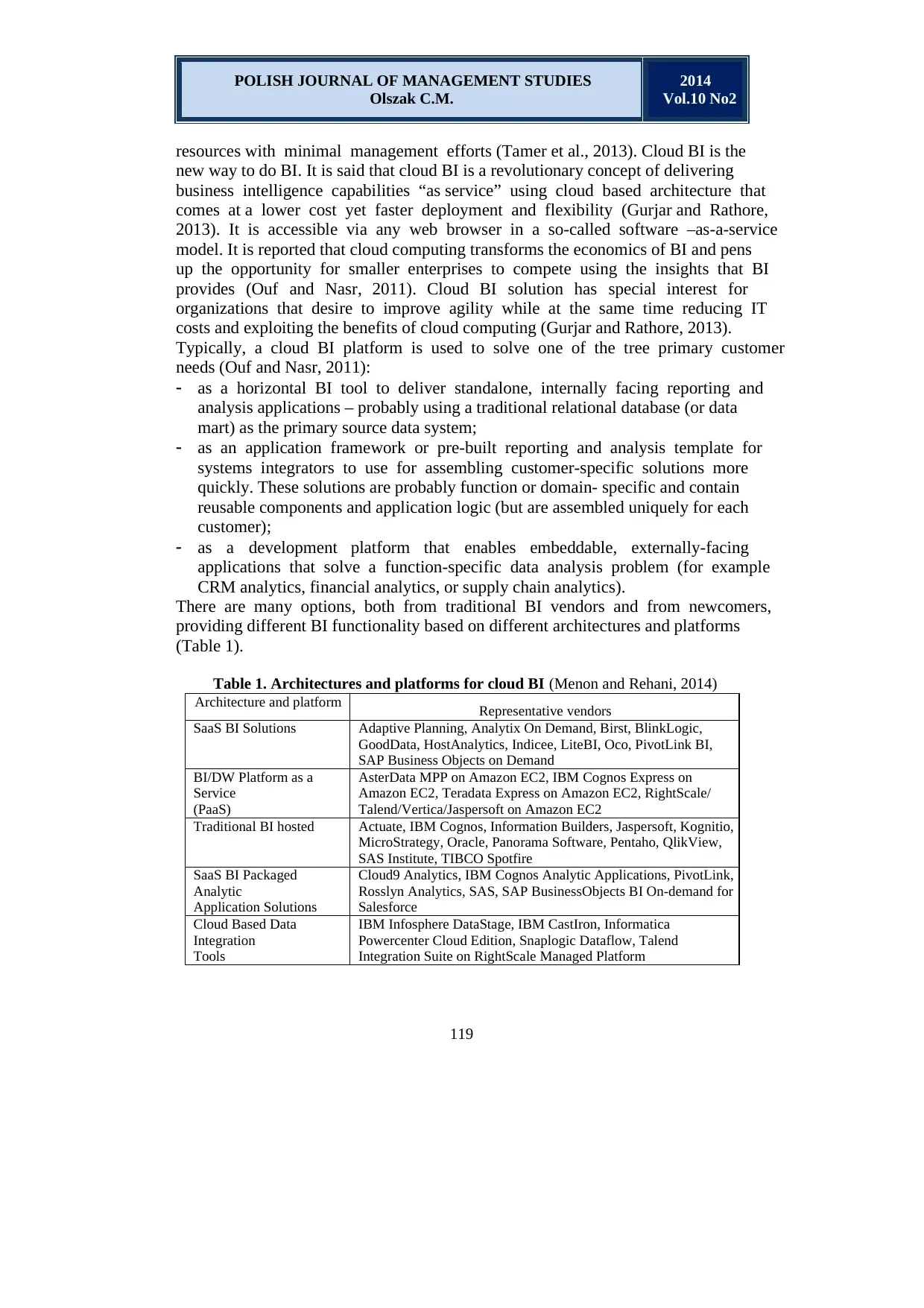
POLISH JOURNAL OF MANAGEMENT STUDIES
Olszak C.M.
2014
Vol.10 No2
119
resources with minimal management efforts (Tamer et al., 2013). Cloud BI is the
new way to do BI. It is said that cloud BI is a revolutionary concept of delivering
business intelligence capabilities “as service” using cloud based architecture that
comes at a lower cost yet faster deployment and flexibility (Gurjar and Rathore,
2013). It is accessible via any web browser in a so-called software –as-a-service
model. It is reported that cloud computing transforms the economics of BI and pens
up the opportunity for smaller enterprises to compete using the insights that BI
provides (Ouf and Nasr, 2011). Cloud BI solution has special interest for
organizations that desire to improve agility while at the same time reducing IT
costs and exploiting the benefits of cloud computing (Gurjar and Rathore, 2013).
Typically, a cloud BI platform is used to solve one of the tree primary customer
needs (Ouf and Nasr, 2011):
as a horizontal BI tool to deliver standalone, internally facing reporting and
analysis applications – probably using a traditional relational database (or data
mart) as the primary source data system;
as an application framework or pre-built reporting and analysis template for
systems integrators to use for assembling customer-specific solutions more
quickly. These solutions are probably function or domain- specific and contain
reusable components and application logic (but are assembled uniquely for each
customer);
as a development platform that enables embeddable, externally-facing
applications that solve a function-specific data analysis problem (for example
CRM analytics, financial analytics, or supply chain analytics).
There are many options, both from traditional BI vendors and from newcomers,
providing different BI functionality based on different architectures and platforms
(Table 1).
Table 1. Architectures and platforms for cloud BI (Menon and Rehani, 2014)
Architecture and platform Representative vendors
SaaS BI Solutions Adaptive Planning, Analytix On Demand, Birst, BlinkLogic,
GoodData, HostAnalytics, Indicee, LiteBI, Oco, PivotLink BI,
SAP Business Objects on Demand
BI/DW Platform as a
Service
(PaaS)
AsterData MPP on Amazon EC2, IBM Cognos Express on
Amazon EC2, Teradata Express on Amazon EC2, RightScale/
Talend/Vertica/Jaspersoft on Amazon EC2
Traditional BI hosted Actuate, IBM Cognos, Information Builders, Jaspersoft, Kognitio,
MicroStrategy, Oracle, Panorama Software, Pentaho, QlikView,
SAS Institute, TIBCO Spotfire
SaaS BI Packaged
Analytic
Application Solutions
Cloud9 Analytics, IBM Cognos Analytic Applications, PivotLink,
Rosslyn Analytics, SAS, SAP BusinessObjects BI On-demand for
Salesforce
Cloud Based Data
Integration
Tools
IBM Infosphere DataStage, IBM CastIron, Informatica
Powercenter Cloud Edition, Snaplogic Dataflow, Talend
Integration Suite on RightScale Managed Platform
Olszak C.M.
2014
Vol.10 No2
119
resources with minimal management efforts (Tamer et al., 2013). Cloud BI is the
new way to do BI. It is said that cloud BI is a revolutionary concept of delivering
business intelligence capabilities “as service” using cloud based architecture that
comes at a lower cost yet faster deployment and flexibility (Gurjar and Rathore,
2013). It is accessible via any web browser in a so-called software –as-a-service
model. It is reported that cloud computing transforms the economics of BI and pens
up the opportunity for smaller enterprises to compete using the insights that BI
provides (Ouf and Nasr, 2011). Cloud BI solution has special interest for
organizations that desire to improve agility while at the same time reducing IT
costs and exploiting the benefits of cloud computing (Gurjar and Rathore, 2013).
Typically, a cloud BI platform is used to solve one of the tree primary customer
needs (Ouf and Nasr, 2011):
as a horizontal BI tool to deliver standalone, internally facing reporting and
analysis applications – probably using a traditional relational database (or data
mart) as the primary source data system;
as an application framework or pre-built reporting and analysis template for
systems integrators to use for assembling customer-specific solutions more
quickly. These solutions are probably function or domain- specific and contain
reusable components and application logic (but are assembled uniquely for each
customer);
as a development platform that enables embeddable, externally-facing
applications that solve a function-specific data analysis problem (for example
CRM analytics, financial analytics, or supply chain analytics).
There are many options, both from traditional BI vendors and from newcomers,
providing different BI functionality based on different architectures and platforms
(Table 1).
Table 1. Architectures and platforms for cloud BI (Menon and Rehani, 2014)
Architecture and platform Representative vendors
SaaS BI Solutions Adaptive Planning, Analytix On Demand, Birst, BlinkLogic,
GoodData, HostAnalytics, Indicee, LiteBI, Oco, PivotLink BI,
SAP Business Objects on Demand
BI/DW Platform as a
Service
(PaaS)
AsterData MPP on Amazon EC2, IBM Cognos Express on
Amazon EC2, Teradata Express on Amazon EC2, RightScale/
Talend/Vertica/Jaspersoft on Amazon EC2
Traditional BI hosted Actuate, IBM Cognos, Information Builders, Jaspersoft, Kognitio,
MicroStrategy, Oracle, Panorama Software, Pentaho, QlikView,
SAS Institute, TIBCO Spotfire
SaaS BI Packaged
Analytic
Application Solutions
Cloud9 Analytics, IBM Cognos Analytic Applications, PivotLink,
Rosslyn Analytics, SAS, SAP BusinessObjects BI On-demand for
Salesforce
Cloud Based Data
Integration
Tools
IBM Infosphere DataStage, IBM CastIron, Informatica
Powercenter Cloud Edition, Snaplogic Dataflow, Talend
Integration Suite on RightScale Managed Platform
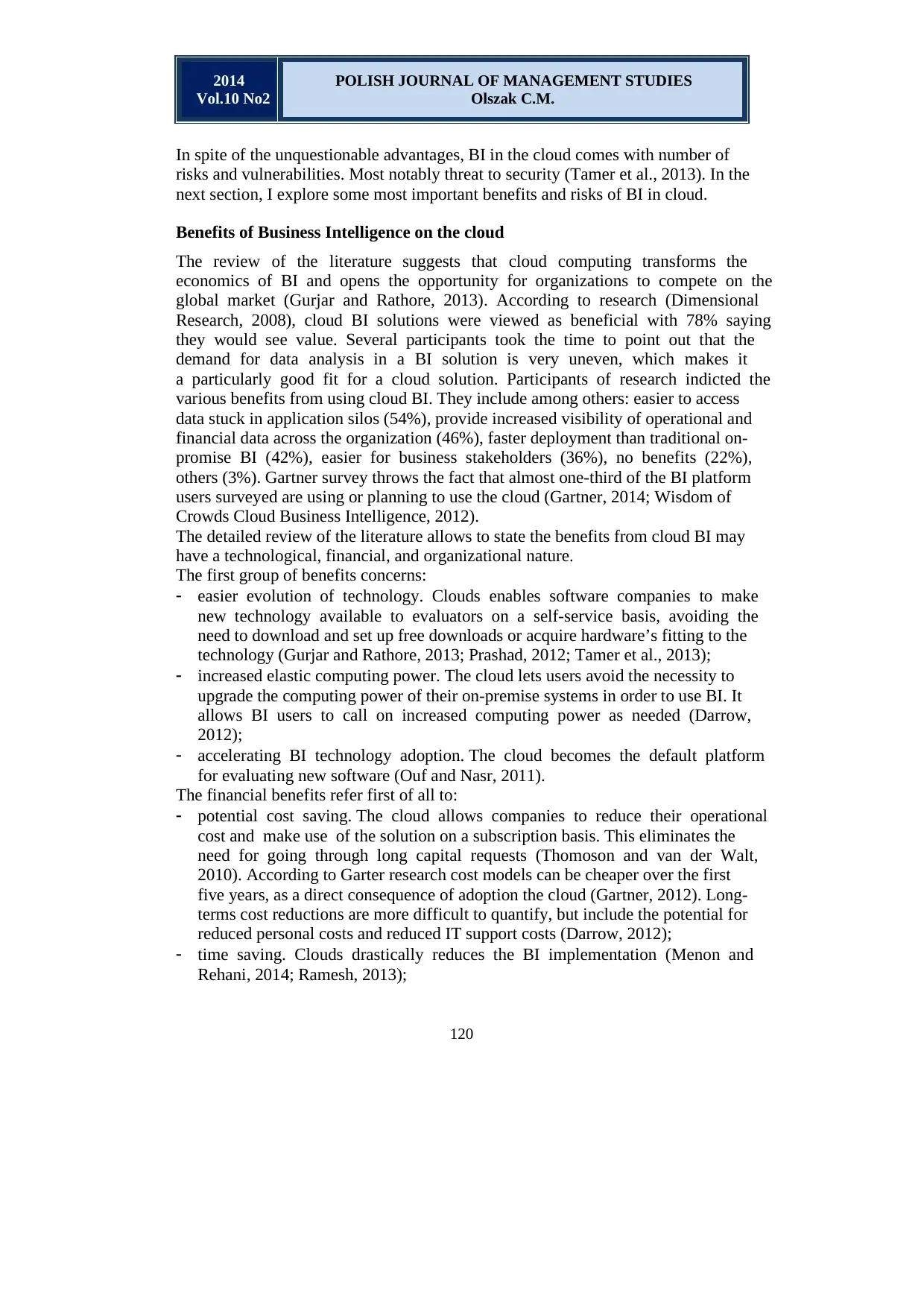
2014
Vol.10 No2
POLISH JOURNAL OF MANAGEMENT STUDIES
Olszak C.M.
120
In spite of the unquestionable advantages, BI in the cloud comes with number of
risks and vulnerabilities. Most notably threat to security (Tamer et al., 2013). In the
next section, I explore some most important benefits and risks of BI in cloud.
Benefits of Business Intelligence on the cloud
The review of the literature suggests that cloud computing transforms the
economics of BI and opens the opportunity for organizations to compete on the
global market (Gurjar and Rathore, 2013). According to research (Dimensional
Research, 2008), cloud BI solutions were viewed as beneficial with 78% saying
they would see value. Several participants took the time to point out that the
demand for data analysis in a BI solution is very uneven, which makes it
a particularly good fit for a cloud solution. Participants of research indicted the
various benefits from using cloud BI. They include among others: easier to access
data stuck in application silos (54%), provide increased visibility of operational and
financial data across the organization (46%), faster deployment than traditional on-
promise BI (42%), easier for business stakeholders (36%), no benefits (22%),
others (3%). Gartner survey throws the fact that almost one-third of the BI platform
users surveyed are using or planning to use the cloud (Gartner, 2014; Wisdom of
Crowds Cloud Business Intelligence, 2012).
The detailed review of the literature allows to state the benefits from cloud BI may
have a technological, financial, and organizational nature.
The first group of benefits concerns:
easier evolution of technology. Clouds enables software companies to make
new technology available to evaluators on a self-service basis, avoiding the
need to download and set up free downloads or acquire hardware’s fitting to the
technology (Gurjar and Rathore, 2013; Prashad, 2012; Tamer et al., 2013);
increased elastic computing power. The cloud lets users avoid the necessity to
upgrade the computing power of their on-premise systems in order to use BI. It
allows BI users to call on increased computing power as needed (Darrow,
2012);
accelerating BI technology adoption. The cloud becomes the default platform
for evaluating new software (Ouf and Nasr, 2011).
The financial benefits refer first of all to:
potential cost saving. The cloud allows companies to reduce their operational
cost and make use of the solution on a subscription basis. This eliminates the
need for going through long capital requests (Thomoson and van der Walt,
2010). According to Garter research cost models can be cheaper over the first
five years, as a direct consequence of adoption the cloud (Gartner, 2012). Long-
terms cost reductions are more difficult to quantify, but include the potential for
reduced personal costs and reduced IT support costs (Darrow, 2012);
time saving. Clouds drastically reduces the BI implementation (Menon and
Rehani, 2014; Ramesh, 2013);
Vol.10 No2
POLISH JOURNAL OF MANAGEMENT STUDIES
Olszak C.M.
120
In spite of the unquestionable advantages, BI in the cloud comes with number of
risks and vulnerabilities. Most notably threat to security (Tamer et al., 2013). In the
next section, I explore some most important benefits and risks of BI in cloud.
Benefits of Business Intelligence on the cloud
The review of the literature suggests that cloud computing transforms the
economics of BI and opens the opportunity for organizations to compete on the
global market (Gurjar and Rathore, 2013). According to research (Dimensional
Research, 2008), cloud BI solutions were viewed as beneficial with 78% saying
they would see value. Several participants took the time to point out that the
demand for data analysis in a BI solution is very uneven, which makes it
a particularly good fit for a cloud solution. Participants of research indicted the
various benefits from using cloud BI. They include among others: easier to access
data stuck in application silos (54%), provide increased visibility of operational and
financial data across the organization (46%), faster deployment than traditional on-
promise BI (42%), easier for business stakeholders (36%), no benefits (22%),
others (3%). Gartner survey throws the fact that almost one-third of the BI platform
users surveyed are using or planning to use the cloud (Gartner, 2014; Wisdom of
Crowds Cloud Business Intelligence, 2012).
The detailed review of the literature allows to state the benefits from cloud BI may
have a technological, financial, and organizational nature.
The first group of benefits concerns:
easier evolution of technology. Clouds enables software companies to make
new technology available to evaluators on a self-service basis, avoiding the
need to download and set up free downloads or acquire hardware’s fitting to the
technology (Gurjar and Rathore, 2013; Prashad, 2012; Tamer et al., 2013);
increased elastic computing power. The cloud lets users avoid the necessity to
upgrade the computing power of their on-premise systems in order to use BI. It
allows BI users to call on increased computing power as needed (Darrow,
2012);
accelerating BI technology adoption. The cloud becomes the default platform
for evaluating new software (Ouf and Nasr, 2011).
The financial benefits refer first of all to:
potential cost saving. The cloud allows companies to reduce their operational
cost and make use of the solution on a subscription basis. This eliminates the
need for going through long capital requests (Thomoson and van der Walt,
2010). According to Garter research cost models can be cheaper over the first
five years, as a direct consequence of adoption the cloud (Gartner, 2012). Long-
terms cost reductions are more difficult to quantify, but include the potential for
reduced personal costs and reduced IT support costs (Darrow, 2012);
time saving. Clouds drastically reduces the BI implementation (Menon and
Rehani, 2014; Ramesh, 2013);
⊘ This is a preview!⊘
Do you want full access?
Subscribe today to unlock all pages.

Trusted by 1+ million students worldwide
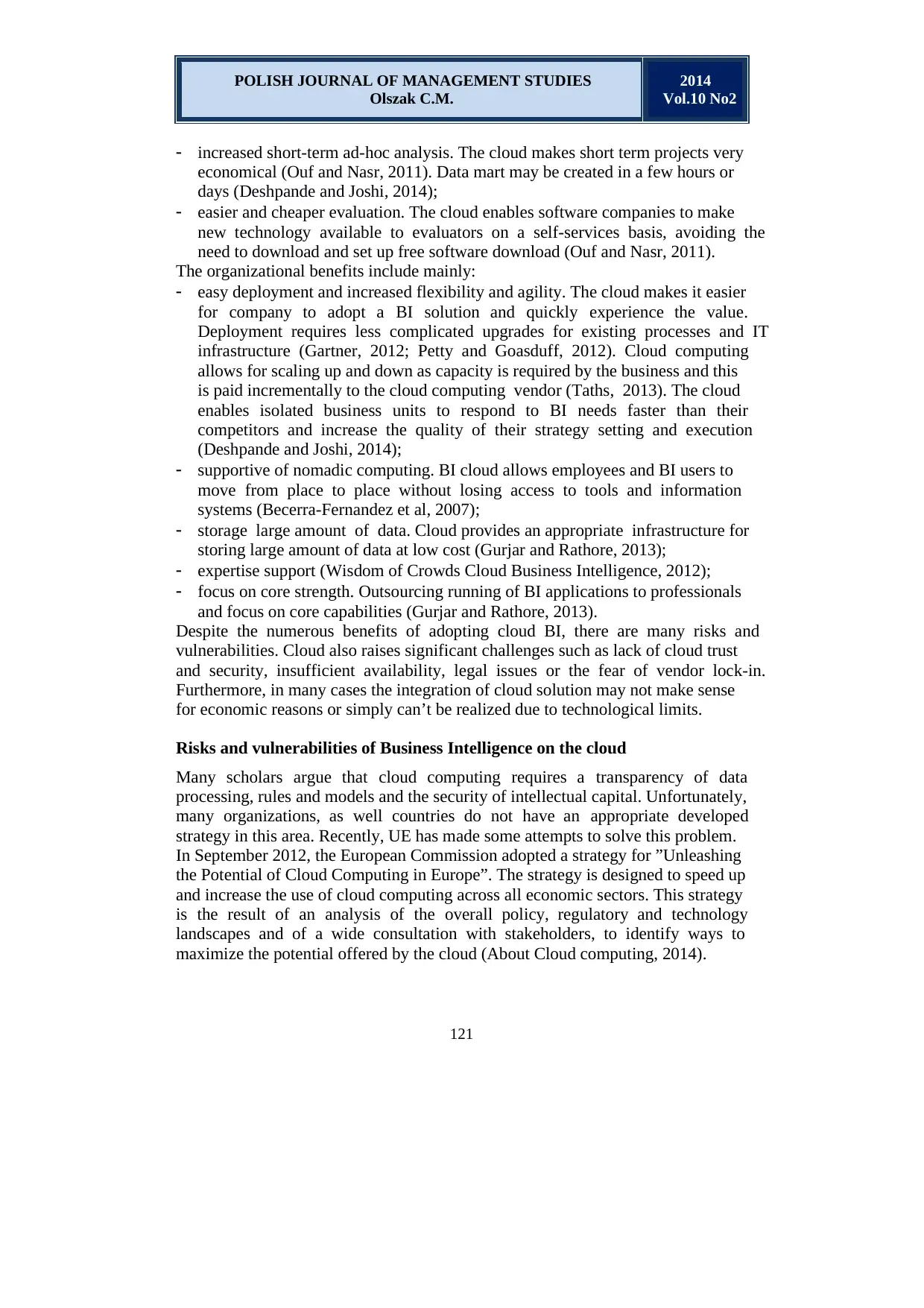
POLISH JOURNAL OF MANAGEMENT STUDIES
Olszak C.M.
2014
Vol.10 No2
121
increased short-term ad-hoc analysis. The cloud makes short term projects very
economical (Ouf and Nasr, 2011). Data mart may be created in a few hours or
days (Deshpande and Joshi, 2014);
easier and cheaper evaluation. The cloud enables software companies to make
new technology available to evaluators on a self-services basis, avoiding the
need to download and set up free software download (Ouf and Nasr, 2011).
The organizational benefits include mainly:
easy deployment and increased flexibility and agility. The cloud makes it easier
for company to adopt a BI solution and quickly experience the value.
Deployment requires less complicated upgrades for existing processes and IT
infrastructure (Gartner, 2012; Petty and Goasduff, 2012). Cloud computing
allows for scaling up and down as capacity is required by the business and this
is paid incrementally to the cloud computing vendor (Taths, 2013). The cloud
enables isolated business units to respond to BI needs faster than their
competitors and increase the quality of their strategy setting and execution
(Deshpande and Joshi, 2014);
supportive of nomadic computing. BI cloud allows employees and BI users to
move from place to place without losing access to tools and information
systems (Becerra-Fernandez et al, 2007);
storage large amount of data. Cloud provides an appropriate infrastructure for
storing large amount of data at low cost (Gurjar and Rathore, 2013);
expertise support (Wisdom of Crowds Cloud Business Intelligence, 2012);
focus on core strength. Outsourcing running of BI applications to professionals
and focus on core capabilities (Gurjar and Rathore, 2013).
Despite the numerous benefits of adopting cloud BI, there are many risks and
vulnerabilities. Cloud also raises significant challenges such as lack of cloud trust
and security, insufficient availability, legal issues or the fear of vendor lock-in.
Furthermore, in many cases the integration of cloud solution may not make sense
for economic reasons or simply can’t be realized due to technological limits.
Risks and vulnerabilities of Business Intelligence on the cloud
Many scholars argue that cloud computing requires a transparency of data
processing, rules and models and the security of intellectual capital. Unfortunately,
many organizations, as well countries do not have an appropriate developed
strategy in this area. Recently, UE has made some attempts to solve this problem.
In September 2012, the European Commission adopted a strategy for ”Unleashing
the Potential of Cloud Computing in Europe”. The strategy is designed to speed up
and increase the use of cloud computing across all economic sectors. This strategy
is the result of an analysis of the overall policy, regulatory and technology
landscapes and of a wide consultation with stakeholders, to identify ways to
maximize the potential offered by the cloud (About Cloud computing, 2014).
Olszak C.M.
2014
Vol.10 No2
121
increased short-term ad-hoc analysis. The cloud makes short term projects very
economical (Ouf and Nasr, 2011). Data mart may be created in a few hours or
days (Deshpande and Joshi, 2014);
easier and cheaper evaluation. The cloud enables software companies to make
new technology available to evaluators on a self-services basis, avoiding the
need to download and set up free software download (Ouf and Nasr, 2011).
The organizational benefits include mainly:
easy deployment and increased flexibility and agility. The cloud makes it easier
for company to adopt a BI solution and quickly experience the value.
Deployment requires less complicated upgrades for existing processes and IT
infrastructure (Gartner, 2012; Petty and Goasduff, 2012). Cloud computing
allows for scaling up and down as capacity is required by the business and this
is paid incrementally to the cloud computing vendor (Taths, 2013). The cloud
enables isolated business units to respond to BI needs faster than their
competitors and increase the quality of their strategy setting and execution
(Deshpande and Joshi, 2014);
supportive of nomadic computing. BI cloud allows employees and BI users to
move from place to place without losing access to tools and information
systems (Becerra-Fernandez et al, 2007);
storage large amount of data. Cloud provides an appropriate infrastructure for
storing large amount of data at low cost (Gurjar and Rathore, 2013);
expertise support (Wisdom of Crowds Cloud Business Intelligence, 2012);
focus on core strength. Outsourcing running of BI applications to professionals
and focus on core capabilities (Gurjar and Rathore, 2013).
Despite the numerous benefits of adopting cloud BI, there are many risks and
vulnerabilities. Cloud also raises significant challenges such as lack of cloud trust
and security, insufficient availability, legal issues or the fear of vendor lock-in.
Furthermore, in many cases the integration of cloud solution may not make sense
for economic reasons or simply can’t be realized due to technological limits.
Risks and vulnerabilities of Business Intelligence on the cloud
Many scholars argue that cloud computing requires a transparency of data
processing, rules and models and the security of intellectual capital. Unfortunately,
many organizations, as well countries do not have an appropriate developed
strategy in this area. Recently, UE has made some attempts to solve this problem.
In September 2012, the European Commission adopted a strategy for ”Unleashing
the Potential of Cloud Computing in Europe”. The strategy is designed to speed up
and increase the use of cloud computing across all economic sectors. This strategy
is the result of an analysis of the overall policy, regulatory and technology
landscapes and of a wide consultation with stakeholders, to identify ways to
maximize the potential offered by the cloud (About Cloud computing, 2014).
Paraphrase This Document
Need a fresh take? Get an instant paraphrase of this document with our AI Paraphraser
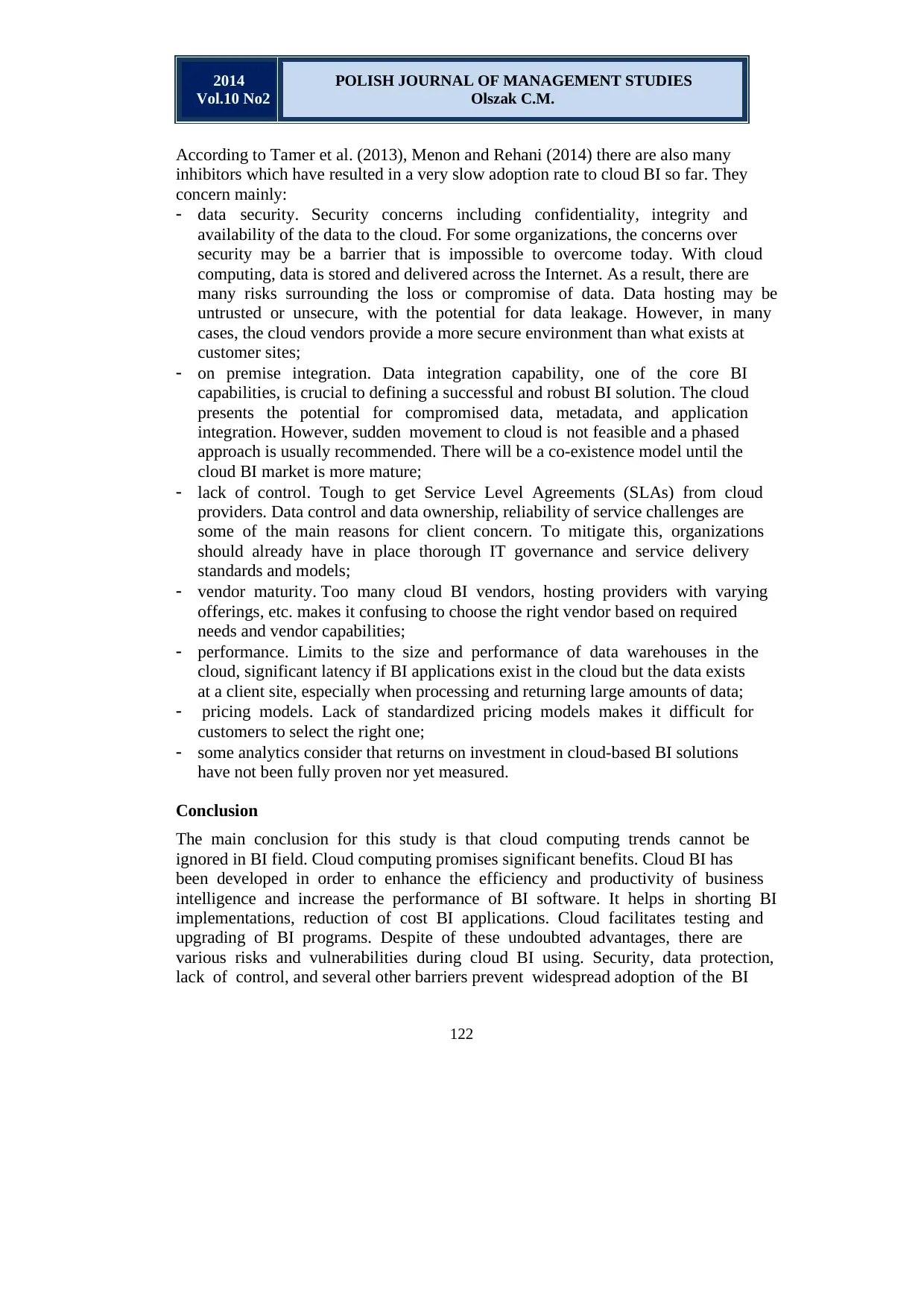
2014
Vol.10 No2
POLISH JOURNAL OF MANAGEMENT STUDIES
Olszak C.M.
122
According to Tamer et al. (2013), Menon and Rehani (2014) there are also many
inhibitors which have resulted in a very slow adoption rate to cloud BI so far. They
concern mainly:
data security. Security concerns including confidentiality, integrity and
availability of the data to the cloud. For some organizations, the concerns over
security may be a barrier that is impossible to overcome today. With cloud
computing, data is stored and delivered across the Internet. As a result, there are
many risks surrounding the loss or compromise of data. Data hosting may be
untrusted or unsecure, with the potential for data leakage. However, in many
cases, the cloud vendors provide a more secure environment than what exists at
customer sites;
on premise integration. Data integration capability, one of the core BI
capabilities, is crucial to defining a successful and robust BI solution. The cloud
presents the potential for compromised data, metadata, and application
integration. However, sudden movement to cloud is not feasible and a phased
approach is usually recommended. There will be a co-existence model until the
cloud BI market is more mature;
lack of control. Tough to get Service Level Agreements (SLAs) from cloud
providers. Data control and data ownership, reliability of service challenges are
some of the main reasons for client concern. To mitigate this, organizations
should already have in place thorough IT governance and service delivery
standards and models;
vendor maturity. Too many cloud BI vendors, hosting providers with varying
offerings, etc. makes it confusing to choose the right vendor based on required
needs and vendor capabilities;
performance. Limits to the size and performance of data warehouses in the
cloud, significant latency if BI applications exist in the cloud but the data exists
at a client site, especially when processing and returning large amounts of data;
pricing models. Lack of standardized pricing models makes it difficult for
customers to select the right one;
some analytics consider that returns on investment in cloud-based BI solutions
have not been fully proven nor yet measured.
Conclusion
The main conclusion for this study is that cloud computing trends cannot be
ignored in BI field. Cloud computing promises significant benefits. Cloud BI has
been developed in order to enhance the efficiency and productivity of business
intelligence and increase the performance of BI software. It helps in shorting BI
implementations, reduction of cost BI applications. Cloud facilitates testing and
upgrading of BI programs. Despite of these undoubted advantages, there are
various risks and vulnerabilities during cloud BI using. Security, data protection,
lack of control, and several other barriers prevent widespread adoption of the BI
Vol.10 No2
POLISH JOURNAL OF MANAGEMENT STUDIES
Olszak C.M.
122
According to Tamer et al. (2013), Menon and Rehani (2014) there are also many
inhibitors which have resulted in a very slow adoption rate to cloud BI so far. They
concern mainly:
data security. Security concerns including confidentiality, integrity and
availability of the data to the cloud. For some organizations, the concerns over
security may be a barrier that is impossible to overcome today. With cloud
computing, data is stored and delivered across the Internet. As a result, there are
many risks surrounding the loss or compromise of data. Data hosting may be
untrusted or unsecure, with the potential for data leakage. However, in many
cases, the cloud vendors provide a more secure environment than what exists at
customer sites;
on premise integration. Data integration capability, one of the core BI
capabilities, is crucial to defining a successful and robust BI solution. The cloud
presents the potential for compromised data, metadata, and application
integration. However, sudden movement to cloud is not feasible and a phased
approach is usually recommended. There will be a co-existence model until the
cloud BI market is more mature;
lack of control. Tough to get Service Level Agreements (SLAs) from cloud
providers. Data control and data ownership, reliability of service challenges are
some of the main reasons for client concern. To mitigate this, organizations
should already have in place thorough IT governance and service delivery
standards and models;
vendor maturity. Too many cloud BI vendors, hosting providers with varying
offerings, etc. makes it confusing to choose the right vendor based on required
needs and vendor capabilities;
performance. Limits to the size and performance of data warehouses in the
cloud, significant latency if BI applications exist in the cloud but the data exists
at a client site, especially when processing and returning large amounts of data;
pricing models. Lack of standardized pricing models makes it difficult for
customers to select the right one;
some analytics consider that returns on investment in cloud-based BI solutions
have not been fully proven nor yet measured.
Conclusion
The main conclusion for this study is that cloud computing trends cannot be
ignored in BI field. Cloud computing promises significant benefits. Cloud BI has
been developed in order to enhance the efficiency and productivity of business
intelligence and increase the performance of BI software. It helps in shorting BI
implementations, reduction of cost BI applications. Cloud facilitates testing and
upgrading of BI programs. Despite of these undoubted advantages, there are
various risks and vulnerabilities during cloud BI using. Security, data protection,
lack of control, and several other barriers prevent widespread adoption of the BI
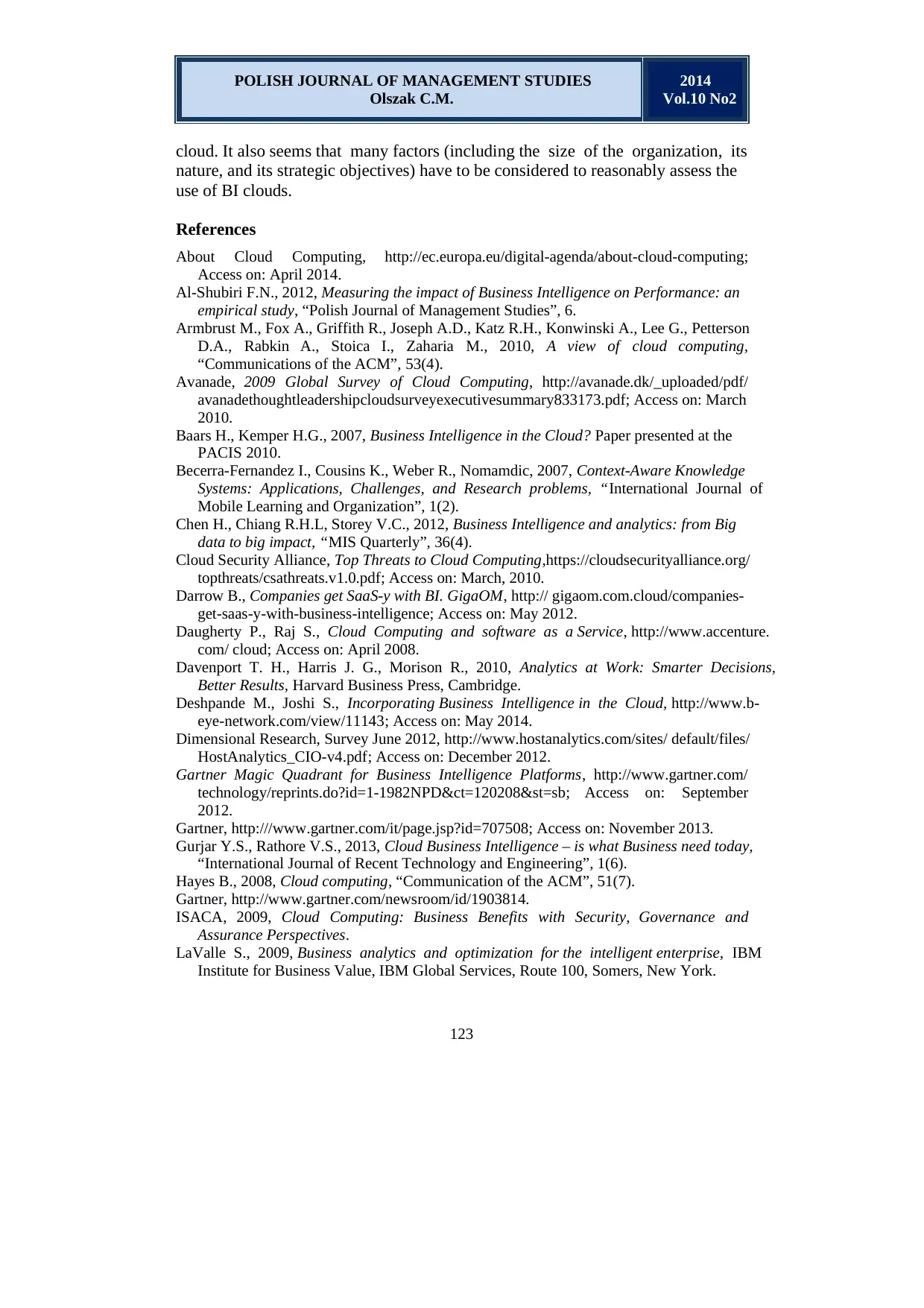
POLISH JOURNAL OF MANAGEMENT STUDIES
Olszak C.M.
2014
Vol.10 No2
123
cloud. It also seems that many factors (including the size of the organization, its
nature, and its strategic objectives) have to be considered to reasonably assess the
use of BI clouds.
References
About Cloud Computing, http://ec.europa.eu/digital-agenda/about-cloud-computing;
Access on: April 2014.
Al-Shubiri F.N., 2012, Measuring the impact of Business Intelligence on Performance: an
empirical study, “Polish Journal of Management Studies”, 6.
Armbrust M., Fox A., Griffith R., Joseph A.D., Katz R.H., Konwinski A., Lee G., Petterson
D.A., Rabkin A., Stoica I., Zaharia M., 2010, A view of cloud computing,
“Communications of the ACM”, 53(4).
Avanade, 2009 Global Survey of Cloud Computing, http://avanade.dk/_uploaded/pdf/
avanadethoughtleadershipcloudsurveyexecutivesummary833173.pdf; Access on: March
2010.
Baars H., Kemper H.G., 2007, Business Intelligence in the Cloud? Paper presented at the
PACIS 2010.
Becerra-Fernandez I., Cousins K., Weber R., Nomamdic, 2007, Context-Aware Knowledge
Systems: Applications, Challenges, and Research problems, “International Journal of
Mobile Learning and Organization”, 1(2).
Chen H., Chiang R.H.L, Storey V.C., 2012, Business Intelligence and analytics: from Big
data to big impact, “MIS Quarterly”, 36(4).
Cloud Security Alliance, Top Threats to Cloud Computing,https://cloudsecurityalliance.org/
topthreats/csathreats.v1.0.pdf; Access on: March, 2010.
Darrow B., Companies get SaaS-y with BI. GigaOM, http:// gigaom.com.cloud/companies-
get-saas-y-with-business-intelligence; Access on: May 2012.
Daugherty P., Raj S., Cloud Computing and software as a Service, http://www.accenture.
com/ cloud; Access on: April 2008.
Davenport T. H., Harris J. G., Morison R., 2010, Analytics at Work: Smarter Decisions,
Better Results, Harvard Business Press, Cambridge.
Deshpande M., Joshi S., Incorporating Business Intelligence in the Cloud, http://www.b-
eye-network.com/view/11143; Access on: May 2014.
Dimensional Research, Survey June 2012, http://www.hostanalytics.com/sites/ default/files/
HostAnalytics_CIO-v4.pdf; Access on: December 2012.
Gartner Magic Quadrant for Business Intelligence Platforms, http://www.gartner.com/
technology/reprints.do?id=1-1982NPD&ct=120208&st=sb; Access on: September
2012.
Gartner, http:///www.gartner.com/it/page.jsp?id=707508; Access on: November 2013.
Gurjar Y.S., Rathore V.S., 2013, Cloud Business Intelligence – is what Business need today,
“International Journal of Recent Technology and Engineering”, 1(6).
Hayes B., 2008, Cloud computing, “Communication of the ACM”, 51(7).
Gartner, http://www.gartner.com/newsroom/id/1903814.
ISACA, 2009, Cloud Computing: Business Benefits with Security, Governance and
Assurance Perspectives.
LaValle S., 2009, Business analytics and optimization for the intelligent enterprise, IBM
Institute for Business Value, IBM Global Services, Route 100, Somers, New York.
Olszak C.M.
2014
Vol.10 No2
123
cloud. It also seems that many factors (including the size of the organization, its
nature, and its strategic objectives) have to be considered to reasonably assess the
use of BI clouds.
References
About Cloud Computing, http://ec.europa.eu/digital-agenda/about-cloud-computing;
Access on: April 2014.
Al-Shubiri F.N., 2012, Measuring the impact of Business Intelligence on Performance: an
empirical study, “Polish Journal of Management Studies”, 6.
Armbrust M., Fox A., Griffith R., Joseph A.D., Katz R.H., Konwinski A., Lee G., Petterson
D.A., Rabkin A., Stoica I., Zaharia M., 2010, A view of cloud computing,
“Communications of the ACM”, 53(4).
Avanade, 2009 Global Survey of Cloud Computing, http://avanade.dk/_uploaded/pdf/
avanadethoughtleadershipcloudsurveyexecutivesummary833173.pdf; Access on: March
2010.
Baars H., Kemper H.G., 2007, Business Intelligence in the Cloud? Paper presented at the
PACIS 2010.
Becerra-Fernandez I., Cousins K., Weber R., Nomamdic, 2007, Context-Aware Knowledge
Systems: Applications, Challenges, and Research problems, “International Journal of
Mobile Learning and Organization”, 1(2).
Chen H., Chiang R.H.L, Storey V.C., 2012, Business Intelligence and analytics: from Big
data to big impact, “MIS Quarterly”, 36(4).
Cloud Security Alliance, Top Threats to Cloud Computing,https://cloudsecurityalliance.org/
topthreats/csathreats.v1.0.pdf; Access on: March, 2010.
Darrow B., Companies get SaaS-y with BI. GigaOM, http:// gigaom.com.cloud/companies-
get-saas-y-with-business-intelligence; Access on: May 2012.
Daugherty P., Raj S., Cloud Computing and software as a Service, http://www.accenture.
com/ cloud; Access on: April 2008.
Davenport T. H., Harris J. G., Morison R., 2010, Analytics at Work: Smarter Decisions,
Better Results, Harvard Business Press, Cambridge.
Deshpande M., Joshi S., Incorporating Business Intelligence in the Cloud, http://www.b-
eye-network.com/view/11143; Access on: May 2014.
Dimensional Research, Survey June 2012, http://www.hostanalytics.com/sites/ default/files/
HostAnalytics_CIO-v4.pdf; Access on: December 2012.
Gartner Magic Quadrant for Business Intelligence Platforms, http://www.gartner.com/
technology/reprints.do?id=1-1982NPD&ct=120208&st=sb; Access on: September
2012.
Gartner, http:///www.gartner.com/it/page.jsp?id=707508; Access on: November 2013.
Gurjar Y.S., Rathore V.S., 2013, Cloud Business Intelligence – is what Business need today,
“International Journal of Recent Technology and Engineering”, 1(6).
Hayes B., 2008, Cloud computing, “Communication of the ACM”, 51(7).
Gartner, http://www.gartner.com/newsroom/id/1903814.
ISACA, 2009, Cloud Computing: Business Benefits with Security, Governance and
Assurance Perspectives.
LaValle S., 2009, Business analytics and optimization for the intelligent enterprise, IBM
Institute for Business Value, IBM Global Services, Route 100, Somers, New York.
⊘ This is a preview!⊘
Do you want full access?
Subscribe today to unlock all pages.

Trusted by 1+ million students worldwide
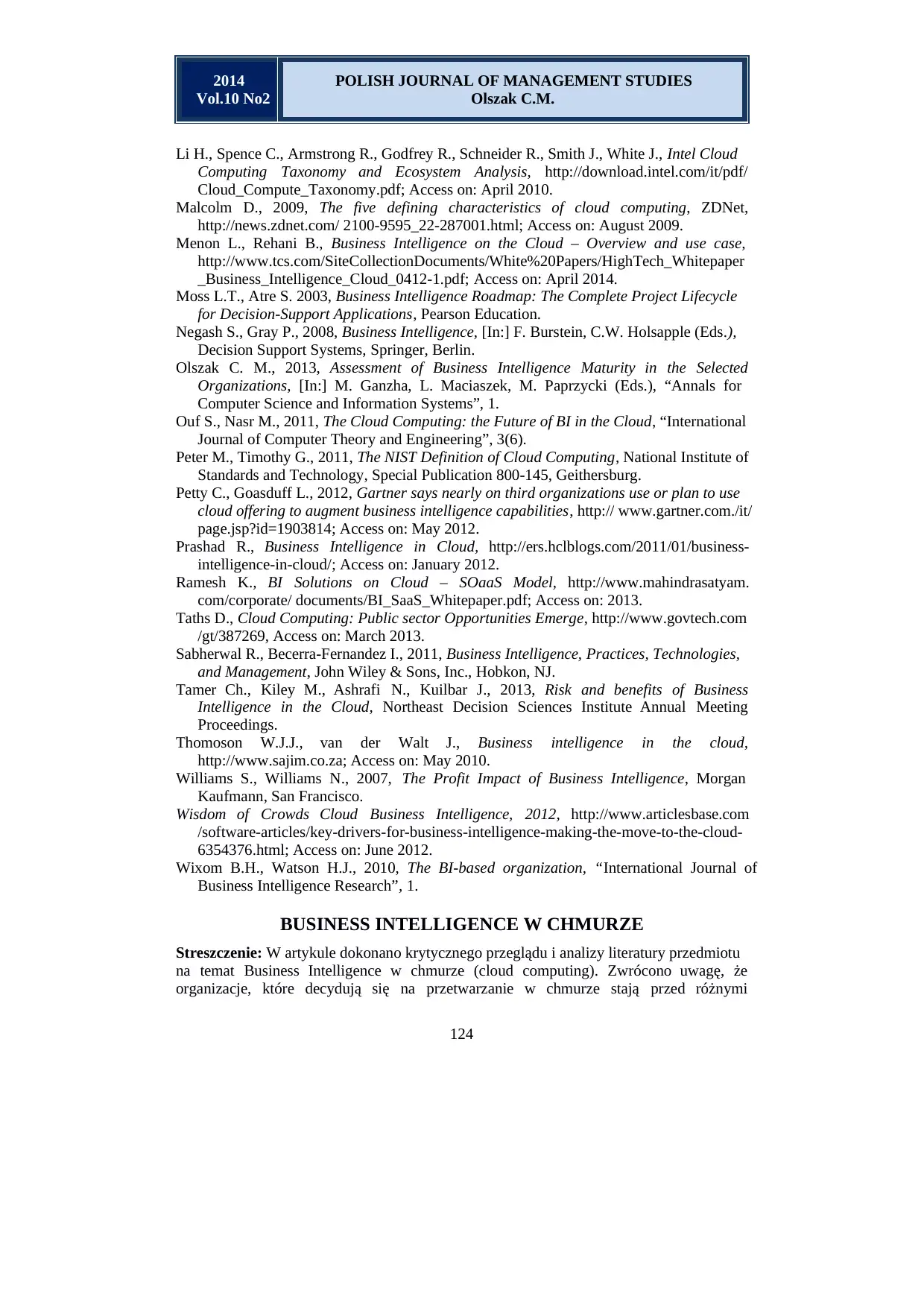
2014
Vol.10 No2
POLISH JOURNAL OF MANAGEMENT STUDIES
Olszak C.M.
124
Li H., Spence C., Armstrong R., Godfrey R., Schneider R., Smith J., White J., Intel Cloud
Computing Taxonomy and Ecosystem Analysis, http://download.intel.com/it/pdf/
Cloud_Compute_Taxonomy.pdf; Access on: April 2010.
Malcolm D., 2009, The five defining characteristics of cloud computing, ZDNet,
http://news.zdnet.com/ 2100-9595_22-287001.html; Access on: August 2009.
Menon L., Rehani B., Business Intelligence on the Cloud – Overview and use case,
http://www.tcs.com/SiteCollectionDocuments/White%20Papers/HighTech_Whitepaper
_Business_Intelligence_Cloud_0412-1.pdf; Access on: April 2014.
Moss L.T., Atre S. 2003, Business Intelligence Roadmap: The Complete Project Lifecycle
for Decision-Support Applications, Pearson Education.
Negash S., Gray P., 2008, Business Intelligence, [In:] F. Burstein, C.W. Holsapple (Eds.),
Decision Support Systems, Springer, Berlin.
Olszak C. M., 2013, Assessment of Business Intelligence Maturity in the Selected
Organizations, [In:] M. Ganzha, L. Maciaszek, M. Paprzycki (Eds.), “Annals for
Computer Science and Information Systems”, 1.
Ouf S., Nasr M., 2011, The Cloud Computing: the Future of BI in the Cloud, “International
Journal of Computer Theory and Engineering”, 3(6).
Peter M., Timothy G., 2011, The NIST Definition of Cloud Computing, National Institute of
Standards and Technology, Special Publication 800-145, Geithersburg.
Petty C., Goasduff L., 2012, Gartner says nearly on third organizations use or plan to use
cloud offering to augment business intelligence capabilities, http:// www.gartner.com./it/
page.jsp?id=1903814; Access on: May 2012.
Prashad R., Business Intelligence in Cloud, http://ers.hclblogs.com/2011/01/business-
intelligence-in-cloud/; Access on: January 2012.
Ramesh K., BI Solutions on Cloud – SOaaS Model, http://www.mahindrasatyam.
com/corporate/ documents/BI_SaaS_Whitepaper.pdf; Access on: 2013.
Taths D., Cloud Computing: Public sector Opportunities Emerge, http://www.govtech.com
/gt/387269, Access on: March 2013.
Sabherwal R., Becerra-Fernandez I., 2011, Business Intelligence, Practices, Technologies,
and Management, John Wiley & Sons, Inc., Hobkon, NJ.
Tamer Ch., Kiley M., Ashrafi N., Kuilbar J., 2013, Risk and benefits of Business
Intelligence in the Cloud, Northeast Decision Sciences Institute Annual Meeting
Proceedings.
Thomoson W.J.J., van der Walt J., Business intelligence in the cloud,
http://www.sajim.co.za; Access on: May 2010.
Williams S., Williams N., 2007, The Profit Impact of Business Intelligence, Morgan
Kaufmann, San Francisco.
Wisdom of Crowds Cloud Business Intelligence, 2012, http://www.articlesbase.com
/software-articles/key-drivers-for-business-intelligence-making-the-move-to-the-cloud-
6354376.html; Access on: June 2012.
Wixom B.H., Watson H.J., 2010, The BI-based organization, “International Journal of
Business Intelligence Research”, 1.
BUSINESS INTELLIGENCE W CHMURZE
Streszczenie: W artykule dokonano krytycznego przeglądu i analizy literatury przedmiotu
na temat Business Intelligence w chmurze (cloud computing). Zwrócono uwagę, że
organizacje, które decydują się na przetwarzanie w chmurze stają przed różnymi
Vol.10 No2
POLISH JOURNAL OF MANAGEMENT STUDIES
Olszak C.M.
124
Li H., Spence C., Armstrong R., Godfrey R., Schneider R., Smith J., White J., Intel Cloud
Computing Taxonomy and Ecosystem Analysis, http://download.intel.com/it/pdf/
Cloud_Compute_Taxonomy.pdf; Access on: April 2010.
Malcolm D., 2009, The five defining characteristics of cloud computing, ZDNet,
http://news.zdnet.com/ 2100-9595_22-287001.html; Access on: August 2009.
Menon L., Rehani B., Business Intelligence on the Cloud – Overview and use case,
http://www.tcs.com/SiteCollectionDocuments/White%20Papers/HighTech_Whitepaper
_Business_Intelligence_Cloud_0412-1.pdf; Access on: April 2014.
Moss L.T., Atre S. 2003, Business Intelligence Roadmap: The Complete Project Lifecycle
for Decision-Support Applications, Pearson Education.
Negash S., Gray P., 2008, Business Intelligence, [In:] F. Burstein, C.W. Holsapple (Eds.),
Decision Support Systems, Springer, Berlin.
Olszak C. M., 2013, Assessment of Business Intelligence Maturity in the Selected
Organizations, [In:] M. Ganzha, L. Maciaszek, M. Paprzycki (Eds.), “Annals for
Computer Science and Information Systems”, 1.
Ouf S., Nasr M., 2011, The Cloud Computing: the Future of BI in the Cloud, “International
Journal of Computer Theory and Engineering”, 3(6).
Peter M., Timothy G., 2011, The NIST Definition of Cloud Computing, National Institute of
Standards and Technology, Special Publication 800-145, Geithersburg.
Petty C., Goasduff L., 2012, Gartner says nearly on third organizations use or plan to use
cloud offering to augment business intelligence capabilities, http:// www.gartner.com./it/
page.jsp?id=1903814; Access on: May 2012.
Prashad R., Business Intelligence in Cloud, http://ers.hclblogs.com/2011/01/business-
intelligence-in-cloud/; Access on: January 2012.
Ramesh K., BI Solutions on Cloud – SOaaS Model, http://www.mahindrasatyam.
com/corporate/ documents/BI_SaaS_Whitepaper.pdf; Access on: 2013.
Taths D., Cloud Computing: Public sector Opportunities Emerge, http://www.govtech.com
/gt/387269, Access on: March 2013.
Sabherwal R., Becerra-Fernandez I., 2011, Business Intelligence, Practices, Technologies,
and Management, John Wiley & Sons, Inc., Hobkon, NJ.
Tamer Ch., Kiley M., Ashrafi N., Kuilbar J., 2013, Risk and benefits of Business
Intelligence in the Cloud, Northeast Decision Sciences Institute Annual Meeting
Proceedings.
Thomoson W.J.J., van der Walt J., Business intelligence in the cloud,
http://www.sajim.co.za; Access on: May 2010.
Williams S., Williams N., 2007, The Profit Impact of Business Intelligence, Morgan
Kaufmann, San Francisco.
Wisdom of Crowds Cloud Business Intelligence, 2012, http://www.articlesbase.com
/software-articles/key-drivers-for-business-intelligence-making-the-move-to-the-cloud-
6354376.html; Access on: June 2012.
Wixom B.H., Watson H.J., 2010, The BI-based organization, “International Journal of
Business Intelligence Research”, 1.
BUSINESS INTELLIGENCE W CHMURZE
Streszczenie: W artykule dokonano krytycznego przeglądu i analizy literatury przedmiotu
na temat Business Intelligence w chmurze (cloud computing). Zwrócono uwagę, że
organizacje, które decydują się na przetwarzanie w chmurze stają przed różnymi
Paraphrase This Document
Need a fresh take? Get an instant paraphrase of this document with our AI Paraphraser
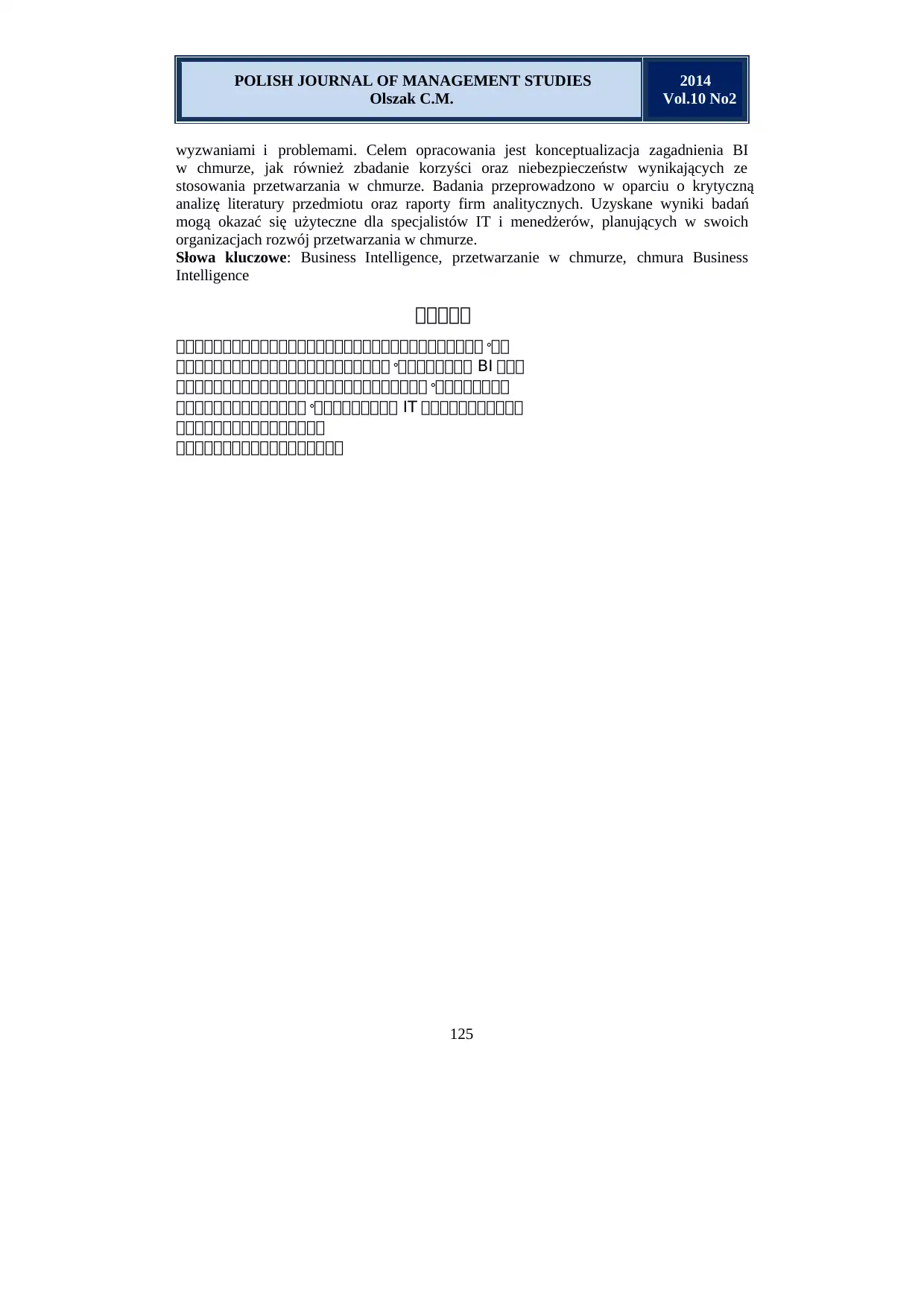
POLISH JOURNAL OF MANAGEMENT STUDIES
Olszak C.M.
2014
Vol.10 No2
125
wyzwaniami i problemami. Celem opracowania jest konceptualizacja zagadnienia BI
w chmurze, jak również zbadanie korzyści oraz niebezpieczeństw wynikających ze
stosowania przetwarzania w chmurze. Badania przeprowadzono w oparciu o krytyczną
analizę literatury przedmiotu oraz raporty firm analitycznych. Uzyskane wyniki badań
mogą okazać się użyteczne dla specjalistów IT i menedżerów, planujących w swoich
organizacjach rozwój przetwarzania w chmurze.
Słowa kluczowe: Business Intelligence, przetwarzanie w chmurze, chmura Business
Intelligence
。
。 BI
。
。 IT
Olszak C.M.
2014
Vol.10 No2
125
wyzwaniami i problemami. Celem opracowania jest konceptualizacja zagadnienia BI
w chmurze, jak również zbadanie korzyści oraz niebezpieczeństw wynikających ze
stosowania przetwarzania w chmurze. Badania przeprowadzono w oparciu o krytyczną
analizę literatury przedmiotu oraz raporty firm analitycznych. Uzyskane wyniki badań
mogą okazać się użyteczne dla specjalistów IT i menedżerów, planujących w swoich
organizacjach rozwój przetwarzania w chmurze.
Słowa kluczowe: Business Intelligence, przetwarzanie w chmurze, chmura Business
Intelligence
。
。 BI
。
。 IT
1 out of 11
Related Documents
Your All-in-One AI-Powered Toolkit for Academic Success.
+13062052269
info@desklib.com
Available 24*7 on WhatsApp / Email
![[object Object]](/_next/static/media/star-bottom.7253800d.svg)
Unlock your academic potential
Copyright © 2020–2025 A2Z Services. All Rights Reserved. Developed and managed by ZUCOL.





